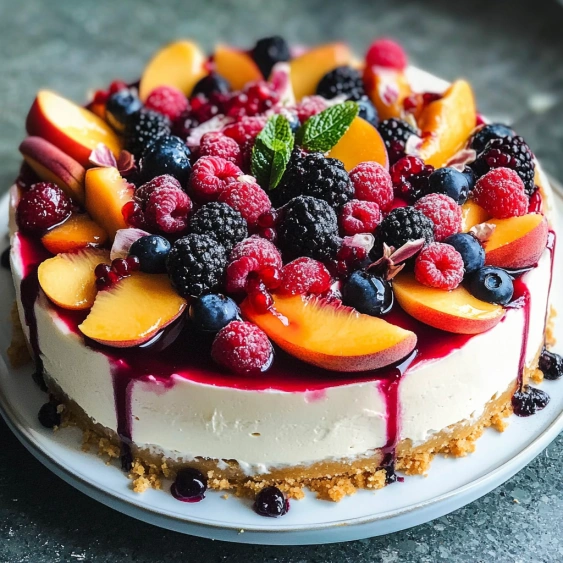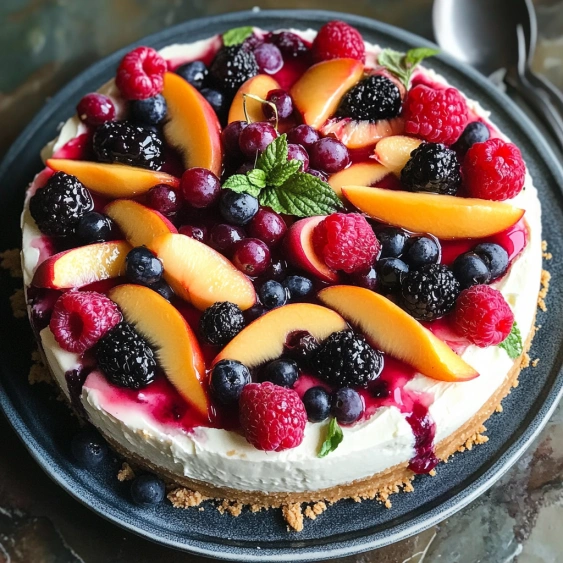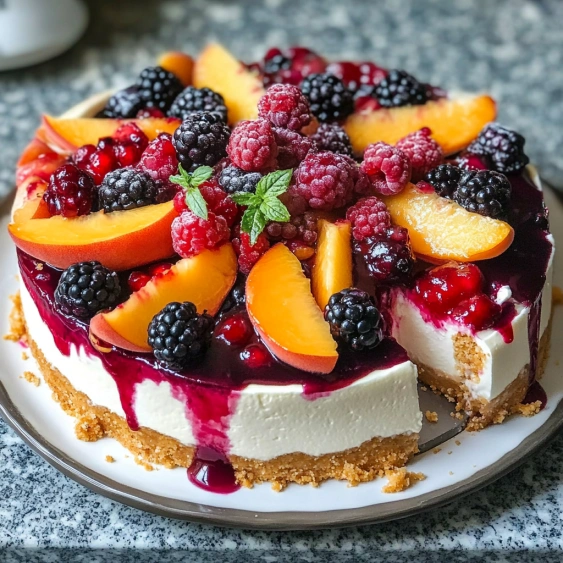 Pin it
Pin it
This luscious summer berry and peach cheesecake combines the creamy richness of classic cheesecake with the vibrant sweetness of fresh seasonal fruits. The contrast between the velvety smooth filling and the burst of fresh berries and juicy peaches creates a dessert that's as beautiful as it is delicious.
I first made this cheesecake for my sister's garden party last summer, and it disappeared within minutes. The guests were taking photos before diving in, and three people asked for the recipe before leaving.
Ingredients
- Graham cracker crumbs: form a buttery, sweet foundation that perfectly complements the creamy filling
- Sugar: brings just the right sweetness to both the crust and filling
- Melted butter: binds the crust together and adds rich flavor
- Cream cheese: creates that iconic smooth, tangy base use full fat for best results
- Vanilla extract: enhances the overall flavor profile with warm aromatic notes
- Eggs: provide structure and richness to the filling
- Sour cream: adds tanginess and creates a velvety texture
- Fresh mixed berries: bring bright color and bursts of sweet tart flavor
- Ripe peaches: add juicy sweetness and beautiful color contrast
Step-by-Step Instructions
- Prepare the pan:
- Preheat your oven to 325°F and thoroughly grease your springform pan, making sure to get into all the crevices. A thin coating of butter works wonders here, ensuring your cheesecake releases cleanly when it's time to serve.
- Create the perfect crust:
- Combine the graham cracker crumbs, sugar, and melted butter in a bowl until the mixture resembles wet sand. Press this mixture firmly into the bottom of your springform pan, using the back of a measuring cup to create an even, compact layer. The more firmly packed your crust, the better it will hold together when sliced.
- Make the filling:
- Beat the cream cheese in a large bowl until completely smooth, about 3 minutes. This step is crucial for preventing lumps in your final cheesecake. Add the sugar and vanilla extract, continuing to beat until the mixture is light and fluffy. The sugar should be fully dissolved, with no graininess detectable.
- Add the eggs:
- Add each egg individually, mixing on low speed until just incorporated before adding the next. Overbeating after adding eggs can incorporate too much air, leading to cracks in your finished cheesecake. Scrape down the sides of the bowl between additions to ensure everything combines evenly.
- Incorporate sour cream:
- Gently fold in the sour cream until completely blended. The mixture should now be silky smooth and pourable. Take care not to overmix at this stage, as the sour cream is what gives your cheesecake that signature velvety texture.
- Assemble and bake:
- Pour your batter over the prepared crust, smoothing the top with a spatula. Arrange your peach slices and berries on top in whatever pattern pleases you. Some berries may sink slightly during baking, creating beautiful pockets of fruit throughout the cheesecake. Bake for 50 to 60 minutes until the center is just set but still has a slight jiggle.
- Cooling process:
- Allow your cheesecake to cool completely at room temperature before refrigerating. This gradual cooling helps prevent the top from cracking. Once at room temperature, refrigerate for at least 4 hours, though overnight is best. This resting period allows the flavors to meld and the texture to set perfectly.
 Pin it
Pin it
The key to this recipe is using truly ripe, in season fruit. I once made this in winter with grocery store berries and the difference was noticeable. Now I only make it during peak summer when I can get peaches so ripe the juice runs down your arm when you bite into them. The wait is absolutely worth it.
Preventing Cheesecake Cracks
The most common problem with homemade cheesecakes is cracking on the surface. To prevent this, always bring your ingredients to room temperature before starting. Cold cream cheese is nearly impossible to beat smooth. Another trick is to avoid opening the oven door during baking. Once finished baking, turn off the oven and leave the door slightly ajar with the cheesecake inside for about an hour. This gradual cooling process helps prevent the dramatic temperature change that often leads to cracks.
Seasonal Fruit Variations
While summer berries and peaches create a classic combination, this cheesecake can be adapted throughout the year. In fall, try thinly sliced apples sprinkled with cinnamon. Winter calls for citrus segments or pomegranate arils. Spring welcomes strawberries and rhubarb. The cream cheese base remains constant while the toppings celebrate whatever is freshest at the market. Just remember that juicier fruits may release more liquid during baking.
 Pin it
Pin it
Serving Suggestions
This cheesecake needs little embellishment, but for special occasions, I like to offer a side of lightly sweetened whipped cream. A drizzle of honey just before serving brings out the natural sweetness of the fruit. For a more dramatic presentation, add a few edible flowers or mint leaves. Serve slices cold from the refrigerator, using a knife dipped in hot water and wiped clean between cuts for the cleanest presentation.
The Secret to a Perfect Texture
Professional pastry chefs know that the ideal cheesecake has a specific consistency somewhere between dense and fluffy. The secret lies in how you incorporate air. Beat the cream cheese and sugar thoroughly until light and fluffy, but once you add the eggs, switch to low speed and mix just until combined. This approach gives you that perfect silky texture that melts in your mouth without being too heavy or too mousse like.
Frequently Asked Questions
- → Can I use frozen berries instead of fresh?
Yes, you can use frozen berries, but thaw and drain them thoroughly first to prevent excess moisture from making your cheesecake soggy. Fresh berries are ideal for the best texture and appearance, especially since they're used as a topping.
- → How do I prevent my cheesecake from cracking?
To prevent cracks, avoid overmixing your batter (which incorporates too much air), bake in a water bath for even heat distribution, and allow the cheesecake to cool gradually in the oven with the door slightly open before moving to room temperature.
- → Can I make this cheesecake ahead of time?
Yes, this cheesecake is actually best made 1-2 days in advance. The extended refrigeration time allows the flavors to develop and ensures the texture is perfectly set. Store covered in the refrigerator for up to 5 days.
- → What can I substitute for graham crackers in the crust?
Digestive biscuits, vanilla wafers, or gingersnaps make excellent substitutes for graham crackers. Simply crush them to the same fine consistency and use the same measurement in the recipe.
- → How do I know when my cheesecake is done baking?
A properly baked cheesecake should be set around the edges but still have a slight jiggle in the center (about 2-3 inches in diameter). The center will continue to set as it cools. Avoid overbaking, which can cause cracks and a dry texture.
- → Can I use other fruits for this cheesecake?
Absolutely! This versatile dessert works well with many fruits. Try mangoes, plums, cherries, or blackberries depending on what's in season. For fall or winter versions, consider using poached pears or sautéed apples.
